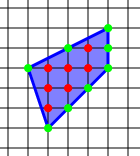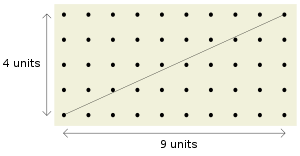Pick's theorem
Given a simple polygon constructed on a grid of equal-distanced points (i.e., points with integer coordinates) such that all the polygon's vertices are grid points, Pick's theorem provides a simple formula for calculating the area A of this polygon in terms of the number i of lattice points in the interior located in the polygon and the number b of lattice points on the boundary placed on the polygon's perimeter:[1]


In the example shown, we have i = 7 interior points and b = 8 boundary points, so the area is A = 7 + 8/2 − 1 = 7 + 4 − 1 = 10 square units.
The theorem as stated above is only valid for simple polygons, i.e., ones that consist of a single, non-self-intersecting boundary (and thus do not contain holes). For a general polygon, Pick's formula generalizes to[2][3]
where is the number of vertices both in and on the boundary of the polygon, is the number of lattice edges on the boundary of the polygon, and is the number of holes in the polygon.
As an example, consider the "polygon" made by connecting the points . It has 3 vertices, 0 holes, and 0 area. To make the formula work, it must have 4 edges. Thus, one just has to count each edge twice, "once on each side".
The result was first described by Georg Alexander Pick in 1899.[4] The Reeve tetrahedron shows that there is no analogue of Pick's theorem in three dimensions that expresses the volume of a polytope by counting its interior and boundary points. However, there is a generalization in higher dimensions via Ehrhart polynomials.
Proof
Consider a polygon P and a triangle T, with one edge in common with P. Assume Pick's theorem is true for both P and T separately; we want to show that it is also true for the polygon PT obtained by adding T to P. Since P and T share an edge, all the boundary points along the edge in common are merged to interior points, except for the two endpoints of the edge, which are merged to boundary points. So, calling the number of boundary points in common c, we have[5]
and
From the above follows
and
Since we are assuming the theorem for P and for T separately,
Therefore, if the theorem is true for polygons constructed from n triangles, the theorem is also true for polygons constructed from n + 1 triangles. For general polytopes, it is well known that they can always be triangulated. That this is true in dimension 2 is an easy fact. To finish the proof by mathematical induction, it remains to show that the theorem is true for triangles. The verification for this case can be done in these short steps:
- observe that the formula holds for any unit square (with vertices having integer coordinates);
- deduce from this that the formula is correct for any rectangle with sides parallel to the axes;
- deduce it, now, for right-angled triangles obtained by cutting such rectangles along a diagonal;
- now any triangle can be turned into a rectangle by attaching such right triangles; since the formula is correct for the right triangles and for the rectangle, it also follows for the original triangle.
The last step uses the fact that if the theorem is true for the polygon PT and for the triangle T, then it's also true for P; this can be seen by a calculation very much similar to the one shown above.
Inequality for convex sets
Let be a bounded, convex region in , not necessarily closed. Then
.[2]
where is the set of lattice points in , and is the number of them.
The proof is by taking the convex hull of , which should be thought of as a lattice approximation of , then apply Pick's theorem to it.
where is the number of boundary points of , which is equal to the number of edges of it, and since each edge is at least length 1, . And the step uses the property that, between two nested, convex, closed curves, the inner one is shorter, which is an application of Crofton formula.
This still works in the degenerate case when is on the same line. One just have to count each edge twice, "once on each side".
References
- Trainin, J. (November 2007). "An elementary proof of Pick's theorem". Mathematical Gazette. 91 (522): 536–540. doi:10.1017/S0025557200182270.
- Garbett, Jennifer (November 18, 2010). "Lattice Point Geometry: Pick's Theorem and Minkowski's Theorem, Senior Exercise in Mathematics" (PDF). Archived from the original (PDF) on 29 August 2017.
- Belyaev, Alexander; Fayolle, Pierre-Alain (2019-08-08). "Counting Parallel Segments: New Variants of Pick's Area Theorem". The Mathematical Intelligencer. 41 (4): 1–7. doi:10.1007/s00283-019-09921-8. ISSN 0343-6993.
- Pick, Georg (1899). "Geometrisches zur Zahlenlehre". Sitzungsberichte des deutschen naturwissenschaftlich-medicinischen Vereines für Böhmen "Lotos" in Prag. (Neue Folge). 19: 311–319. JFM 33.0216.01. CiteBank:47270
- Beck, Matthias; Robins, Sinai (2007). Computing the Continuous Discretely: Integer-point enumeration in polyhedra. Undergraduate Texts in Mathematics. New York: Springer-Verlag. ch. 2. ISBN 978-0-387-29139-0. MR 2271992.
External links
| Wikimedia Commons has media related to Pick's theorem. |
- Pick's Theorem (Java) at cut-the-knot
- Pick's Theorem
- Pick's Theorem proof by Tom Davis
- Pick's Theorem by Ed Pegg, Jr., the Wolfram Demonstrations Project.
- Weisstein, Eric W. "Pick's Theorem". MathWorld.